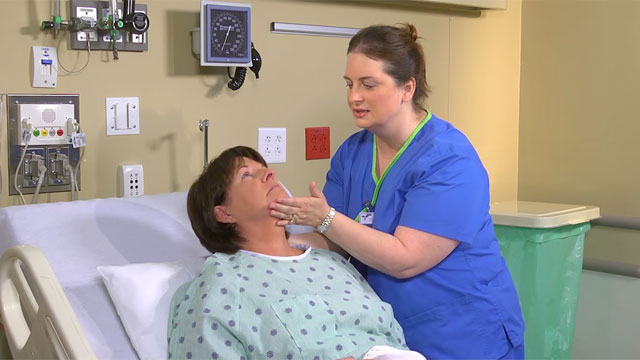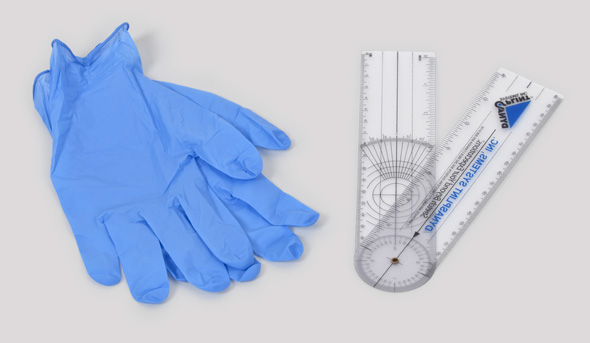Safe Patient Handling
Select a Skill:
- » Assisting with Moving a Patient in Bed
- » Assisting with Positioning a Patient in Bed
- » Transferring from a Bed to a Wheelchair Using a Transfer Belt
- » Transferring from a Bed to a Stretcher
- » Performing Passive Range-of-Motion Exercises
- » Applying Elastic Stockings
- » Assisting with Ambulation Using a Gait Belt
- » Using a Sequential Compression Device
- » Using a Hydraulic Lift
Take the Review Test:

Safety
- Prepare the patient. Make sure that the patient is rested and not fatigued.
- Perform exercises slowly, and provide adequate support to each joint being exercised.
- Do not exercise joints beyond the point of resistance or to the point of fatigue or pain.
- When you note resistance within a joint, do not force the joint motion. Consult with the health care provider or a physical therapist.
- Patients with spinal cord or orthopedic trauma usually require ROM exercise by specialized health care professionals or physical therapists.
Equipment
(Roll cursor over items to see labels)

Clean Gloves
Goniometer
Delegation
The skill of performing ROM exercises can be delegated to nursing assistive personnel (NAP). Be sure to inform NAP of the following:
- Remind NAP not to perform exercises on any patient with spinal cord or orthopedic trauma, since exercising will be done by a specialized health care professional or physical therapist.
- Remind NAP to perform exercises slowly and to provide adequate support to each joint being exercised.
- Caution NAP not to exercise joints beyond the point of resistance or to the point of fatigue or pain.
- Discuss the patient’s individual limitations or preexisting conditions, such as arthritis, that may affect ROM.
Preparation
- Review the patient’s chart for physical assessment findings, health care provider’s orders, medical diagnoses, medical history, and progress.
- Obtain data on the patient’s baseline joint function. Observe for limitations in joint mobility; redness or warmth over joints; joint tenderness; joint deformities; and crepitus produced by joint motion.
- Assess the patient’s level of comfort (on a scale of 0 to 10, with 0 being no pain and 10 being the worst pain possible) before exercising. Determine if the patient would benefit from receiving pain medication before beginning ROM exercises.
- Determine the patient’s or family caregiver’s readiness to learn. Explain all rationales for the ROM exercises, and describe and demonstrate the exercises to be performed.
- Know the patient’s home care plan. The patient may need to continue the exercise regimen or use an assistive device at home.
Follow-up
- Observe the patient performing ROM activities.
- Evaluate the patient’s response to the ROM exercises. Note any discomfort or fatigue.
- Compare the patient’s performance of ROM exercises to the baseline.
- Measure the patient’s joint motion as needed.
- Monitor the patient for any pain throughout the ROM exercise period.
Documentation
Record which joints were exercised with passive ROM exercises, type of exercise performed, number of repetitions of each exercise, extent to which the joints can be moved, any joint abnormalities, your assessment of the patient’s muscular strength and comfort after exercise, the patient’s subjective statements regarding muscular strength, and the patient’s ability to perform the exercises.
Review Questions
1. Which patient is most at risk of developing permanently impaired mobility?
 A 72-year-old woman hospitalized for anemia associated with diabetic nephropathy (kidney disease)
A 72-year-old woman hospitalized for anemia associated with diabetic nephropathy (kidney disease) A 55-year-old woman with mental illness who had become malnourished
A 55-year-old woman with mental illness who had become malnourished An 11-year-old boy who sustained a fractured pelvis during a fall from his tree house
An 11-year-old boy who sustained a fractured pelvis during a fall from his tree house A 79-year-old man recovering from surgery to release a contracture of the connective tissue in his hand
A 79-year-old man recovering from surgery to release a contracture of the connective tissue in his hand
2. The nurse is performing passive shoulder and elbow exercises for a patient who is recovering from surgery to remove a soft-tissue tumor in her upper arm. Why does the nurse cup one hand around the patient’s elbow and support the forearm and wrist during the ROM exercises?
 To keep the arm above the level of the heart
To keep the arm above the level of the heart  To assess the patient’s muscle tension
To assess the patient’s muscle tension  To listen for crepitus in the joint
To listen for crepitus in the joint  To ensure stability while exercising the joint
To ensure stability while exercising the joint
3. The nurse notes that a patient's left elbow is resistant to extention and flexion while performing range of motion exercises. What is the appropriate nursing action?
 Move joint through full range of motion exercises.
Move joint through full range of motion exercises. Perform range of motion to the left elbow until resistance is met.
Perform range of motion to the left elbow until resistance is met. Omit all range of motion exercises until the health care provider is notified.
Omit all range of motion exercises until the health care provider is notified. Inform the health care provider that the patient is uncooperative with exercising.
Inform the health care provider that the patient is uncooperative with exercising.
4. Which of the following are basic guidelines when assisting a patient with passive range of motion?
 Exercises should be continued until the point of fatigue and pain.
Exercises should be continued until the point of fatigue and pain. Exercises should be done frequently to lessen pain for the patient.
Exercises should be done frequently to lessen pain for the patient. Each joint is exercised to the point of resistance but not pain.
Each joint is exercised to the point of resistance but not pain. Exercises should be performed without the support to each joint.
Exercises should be performed without the support to each joint.
5. Why would the nurse ask a physical therapist to perform passive ROM exercises for a patient with lower extremity injuries sustained in a motor vehicle crash?
 The patient is an older adult or has a chronic condition.
The patient is an older adult or has a chronic condition. The patient is reluctant to perform the exercises because he is worried about reinjury.
The patient is reluctant to perform the exercises because he is worried about reinjury. The patient has orthopedic trauma.
The patient has orthopedic trauma.  The patient has pain exacerbated by exercise.
The patient has pain exacerbated by exercise.
You have completed the Review Questions for this skill. To take the Review again select the Start Over button. To proceed to another skill select from the dropdown menu. Select the Home or Back button to proceed to the next section.

